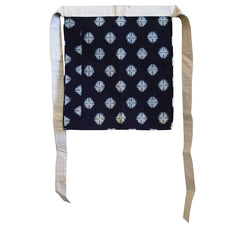A Densely Sashiko Stitched Apron: Mid to Late 20th Century Kasuri
ca. mid to late twentieth century
kasuri area: 16 3/4" x 16", 42.5 cm x 40.5 cm
Aprons were worn all the time in old Japan by all classes of people, especially working people.
Women at home wore them to do housekeeping, farmers and tradesmen wore
them, shopkeepers wore them--in the past, aprons or maekake were
part of one's daily clothing, and, still, today, many people today in
Japan wear aprons on a daily basis.
This apron is most likely stitched in the mid to late twentieth century, and stitched it is.
The apron section of this garment is made of two layers of cotton cloth: the front is a large-scale kasuri or ikat which is indigo dyed; the back is a subtle, striped cotton--and these two layers are held together by tight, close, and tightly stitched rows of sashiko stitching, the result showing a nubbly surface texture from the amount of stitching compressed into one, small piece of cloth.
The tie is a recycled length of heavy, powerloomed cotton that has been machine stitched to the kasuri base. This white cotton tie, rather stiff, shows scuffs and some surface soiling.
All in all, this is a really attractive and beautifully presented sashiko stitched garment--and very tradition in its conception and execution.

